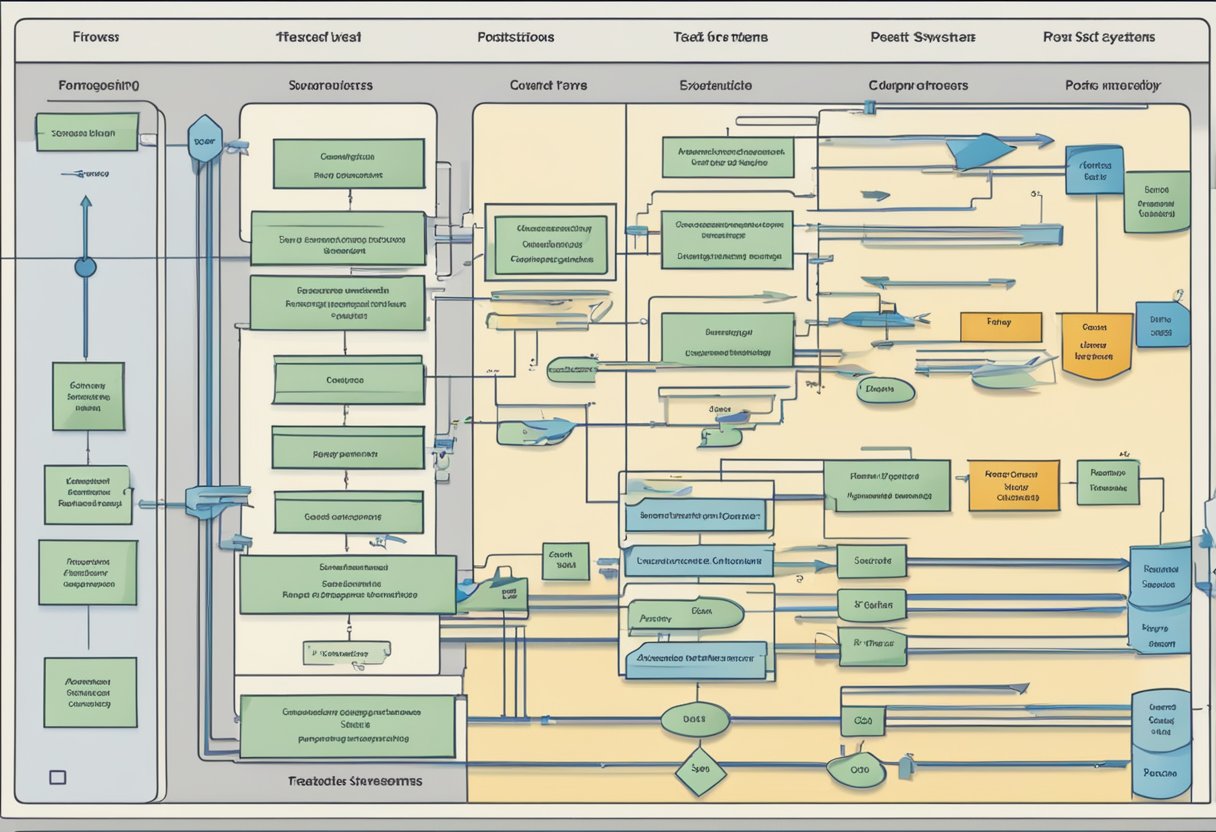Agile Methodologies in Post-Trade Systems: A Comprehensive Overview
Get a comprehensive overview of agile methodologies in post-trade systems. Read our informative article to discover how this approach can benefit your business.

Agile methodologies have transformed industries by providing a flexible and collaborative approach to handling complex tasks. The financial sector, particularly in post-trade systems, is no exception. Implementing agile methodologies in post-trade processes allows banks to adapt rapidly to changing market conditions and increase their risk management, settlements, and reporting efficiency.

In recent years, more banks have embraced agile methodologies to drive innovation and improve performance in post-trade systems. Due to the dynamic nature of the financial markets, traditional approaches to risk management and asset allocation are not sufficient anymore. The agile approach, emphasizing iterative development and continuous improvement, enables better management of post-trade activities and supports the adaptation to emerging trends and regulatory changes.
As banks continue to adopt and integrate agile methodologies into their post-trade systems, they leverage digital tools and resources to speed up implementation and improve team collaboration. Moreover, agile practices encourage greater diversity and inclusion, ensuring that varied perspectives contribute to developing and managing post-trade systems. This cultural shift is accelerating the evolution of post-trade processes, leading to more efficient and effective systems that can better respond to market challenges.
Key Takeaways
- Agile methodologies enhance efficiency and adaptability in post-trade systems.
- Banks are increasingly embracing agile approaches for improved innovation and performance.
- Digital tools and a diverse and inclusive culture support the successful implementation of agile methodologies in post-trade systems.
Understanding Agile Methodologies
Agile methodologies are a set of flexible and iterative project management frameworks emphasizing continuous improvement, adaptability, and delivering consistent value to stakeholders. Some popular Agile frameworks include Scrum, Kanban, and Extreme Programming (XP). These methodologies are particularly useful in software development, where the need for rapid response to change and the collaborative nature of teams are well-suited to the Agile approach.
Difference between Agile and Waterfall
Agile and Waterfall are two contrasting approaches to project management and software development. While Agile focuses on flexibility, adaptations, and iterative progress, Waterfall is a more linear and rigid approach.
Agile:
- Iterative and flexible
- Emphasizes collaboration within teams and with stakeholders
- Allows changes and adaptations throughout the project
- Provides value incrementally through a series of functional releases
Waterfall:
- Linear and rigid
- Separate, sequential phases (requirements, design, implementation, testing, etc.)
- There is little room for changes or adaptations once a phase is complete
- The entire project is delivered at once upon completion
Agile methodologies are well-suited for complex, rapidly changing environments, such as post-trade systems because they can improve communication, adapt to changing requirements, and deliver consistent value to stakeholders. By contrast, the Waterfall model is more appropriate for straightforward, predictable projects where conditions are well-defined and unlikely to change throughout the project's duration.
Role of Agile in Post-Trade Systems
Efficiency in Clearing and Compliance
Adopting Agile methodologies in post-trade systems provides substantial benefits in terms of efficiency and compliance. As the financial markets evolve, organizations must adapt their processes to ensure proper clearing and settlement of transactions. Agile principles support this adaptability by emphasizing continuous improvement and iterative development.
In the post-trade environment, clearing and compliance are critical components to maintain the stability and integrity of financial markets. Clearing refers to the process in which financial transactions are settled with the help of clearinghouses that act as intermediaries to ensure smooth execution. On the other hand, compliance ensures that organizations adhere to the regulations set forth by financial authorities.
Agile methodologies, such as Scrum and Kanban, facilitate quicker response to market conditions, regulations, or organizational needs changes. They prioritize the most important tasks and help post-trade teams collaborate more effectively. This improved collaboration leads to faster identification of issues, allowing for quick resolution and reduced risks.
Moreover, Agile enables faster adaptation to regulatory changes, ensuring that compliance is always maintained. By incorporating an adaptive approach that responds to evolving regulations, organizations can avoid potential fines or sanctions related to non-compliance.
In summary, implementing Agile methodologies in post-trade systems significantly contributes to the efficiency of clearing and compliance processes. Organizations can maintain regulatory compliance and ensure smooth transaction settlement in an ever-changing financial landscape by embracing iterative development, adaptability, and priority-driven tasks.
Applications of Agile in Asset and Risk Management

Impact on Fixed Income Projects
Agile methodologies have increasingly been adopted in the financial industry, particularly asset and risk management. They have shown effectiveness in enhancing efficiency, reducing time-to-market, and improving the overall quality of economic projects. One area that has seen a significant impact through implementing Agile methodologies is fixed-income projects.
Fixed-income projects involve complex risk management processes, such as bond issuances and portfolio management. Traditional waterfall methods often fail to address the rapidly changing market and regulatory environment adequately. Agile methodologies promote iterative development, continuous integration, and cross-functional collaboration, which can significantly benefit fixed-income projects, especially in managing risks associated with bond pricing, interest rate fluctuations, and credit risks. For instance, Agile enables teams to reassess and adjust risk mitigation strategies based on real-time market data and changing requirements.
In asset management, Agile methodologies facilitate better communication and collaboration between stakeholders, such as portfolio managers, analysts, and risk management professionals. This helps to streamline decision-making processes, allowing for a more effective allocation of resources and more robust risk management. Agile can lead to a more adaptable and responsive asset management strategy by emphasizing continuous improvement and learning from each iteration.
When it comes to fixed-income projects, Agile methodologies can be integrated into several aspects, including:
- Portfolio Construction: Agile principles encourage cross-functional teams to work together in optimizing portfolios with a clear focus on risk mitigation and asset allocation. This leads to a more dynamic approach to portfolio construction, considering risk factors and market conditions.
- Risk Assessment: Agile fosters frequent risk assessment cycles and continuous monitoring to ensure better risk identification, analysis, and mitigation. This approach allows for more informed decision-making and reduces the likelihood of potentially disruptive surprises in fixed-income projects.
- Compliance & Regulation: Adapting to regulatory changes is critical to managing fixed-income projects. Agile methodologies allow teams to respond quickly to new or amended regulations, ensuring ongoing compliance.
Adopting Agile methodologies in asset and risk management, particularly within fixed-income projects, leads to a more proactive and adaptive approach to managing risks and achieving an organization's objectives. Financial institutions can build robust and resilient strategies in an ever-changing market landscape by embracing Agile principles.
Cultural Shift: Banks Embracing Agile Methodologies
The banking industry has experienced a significant shift in recent years, with many banks recognizing the benefits of embracing agile methodologies. Agile methodologies focus on empowering teams, increasing collaboration, and rapidly adapting to change. This approach allows banks to react quickly to market fluctuations and evolving customer needs, essential in an industry characterized by growth and low rates.
One major factor influencing this shift is the increased need for banks to keep pace with the rapidly changing financial landscape. The agile operating model has proven relevant for banking, enabling organizations to adapt to evolving priorities and operating processes effectively. Banks must quickly adjust their strategies to stay competitive and respond to changing customer expectations, regulatory requirements, and technological advancements.
Adopting agile methodologies can also lead to improvements in the overall culture within the organization. Agile teams are empowered to take ownership of their work, contributing more actively to project success, ultimately leading to a cultural shift towards ownership. By replacing the traditional top-down, command-and-control structure with a focus on collaboration and flexibility, banks can foster a healthier work environment that nurtures innovation, creativity and employee morale.
Moreover, agile methodologies emphasize iterative, incremental progress, enabling banks to rapidly test and learn from new products, features, and services. This helps banks to refine their offerings based on customer feedback, resulting in a more customer-centric approach. Banks that successfully integrate agile principles into their operations are better positioned to meet the demands of a changing business environment while continuously providing value to their customers.
In conclusion, the shift towards embracing agile methodologies in the banking industry indicates how banks have recognized the need for more responsiveness, flexibility, and efficiency in their operations. By undergoing this cultural transformation, banks can better adapt to the rapid changes in the financial landscape and foster continued growth in the face of low rates and increasing competition.
Inclusion and Diversity in Agile Projects
Inclusion and diversity are essential in Agile projects, as they encourage new ideas and foster creativity among team members. By creating a workforce that values individuals from various backgrounds, such as race, religion, sex, sexual orientation, and disability, Agile projects benefit from a broad range of perspectives that lead to innovative solutions and more effective decision-making.
Ensuring equal opportunity for all employees is advantageous for the business and contributes to equitable and inclusive work environments. When organizations prioritize diversity, they create a space for employees with different gender identities, cultures, and experiences to contribute to the project's success. Moreover, Agile methodologies, emphasizing collaboration and flexibility, provide an ideal framework for encouraging diverse contributions at every process stage.
Addressing diversity and inclusion within Agile projects requires deliberate action from leaders and team members. It begins with understanding and acknowledging cultural differences that may exist within teams. The impact of culture on Agile implementation is crucial, as cultural norms may profoundly influence a team's overall dynamics and performance.
Additionally, project managers and team members must actively work together to promote a culture of support, respect, and inclusiveness. Communication, transparency, and feedback are vital to effective diversity and inclusion practices in Agile projects. Regularly sharing progress, offering constructive feedback, and welcoming open dialogue on issues related to diversity can help foster a diverse and inclusive environment.
In summary, Agile projects thrive when inclusion and diversity are embraced. Organizations can create innovative solutions and achieve more substantial outcomes by recognizing and addressing business needs from various perspectives. Prioritizing equal opportunity and embodying an inclusive attitude in Agile projects demonstrates a commitment to individual employees and the project's overall success.
Leveraging Digital Tools for Agile Implementations
With the growing demand for agile methodologies in post-trade systems, leveraging digital tools has become essential to enhance efficiency, collaboration, and adaptability. One such digital tool that plays a significant role in agile projects is Jira.
Role of Jira in Agile Projects
Jira, a project management tool designed by Atlassian, enables teams to plan, track, and release software effectively. It is an invaluable resource for organizations seeking digital innovation, as it provides a platform to implement various agile methodologies like Scrum, Kanban, and Scrumban.
The tool offers features such as custom dashboards, backlog management, and detailed reporting, which enables teams to monitor their progress and quickly adapt to changes. Jira is beneficial for managing complex architecture projects, as it allows for easy breakdown and visualization of tasks through its intuitive user interface.
Some of the benefits Jira brings to agile projects include:
- Enhanced collaboration: Jira fosters communication among team members, reduces silos, and encourages an iterative approach to problem-solving. It helps teams stay aligned with their goals and maintain transparency throughout the project lifecycle.
- Adaptability: Jira supports various agile methodologies, making it suitable for teams with diverse preferences and workflows. It allows teams to customize their approach to project management and adapt to changing requirements.
- Efficient tracking: Jira's comprehensive reporting and tracking features provide insights into a project's progress, enabling teams to identify bottlenecks and optimize their workflow accordingly.
- Integration: Jira seamlessly integrates with other tools and platforms, making it an ideal choice for organizations that rely on multiple software systems for their development processes.
In conclusion, Jira is a powerful and versatile tool that effectively enables teams to implement agile methodologies in post-trade systems. By offering a robust platform for collaboration, adaptability, and efficient project management, Jira plays a pivotal role in driving digital innovation and transforming the architecture of post-trade systems.
Future Trends: Agile and AI in Cloud-Based Systems
The increasing demand for efficient and innovative solutions has led to the developing and implementation of Agile methodologies in post-trade systems. Integrating Agile methods with artificial intelligence (AI) and cloud-based technologies is paving the way for advanced, scalable, and more robust systems in the financial industry.
Agile methodologies offer several benefits, such as flexibility, adaptability, and quicker response times, which are essential for developing complex post-trade systems. With AI advancements, these systems can leverage machine learning algorithms and data processing capabilities to analyze vast amounts of data in real time, enhancing decision-making processes and automating various functions.
Cloud-based technologies further enhance the capabilities of Agile and AI-driven systems by providing an on-demand, scalable, and accessible platform for system development and execution. With cloud platforms, businesses can deploy their Agile-based post-trade systems in a highly available and secure environment. This flexibility enables organizations to leverage the benefits of AI while maintaining optimal resource utilization and costs.
The convergence of Agile, digital, and AI transformation is resulting in the emergence of several key trends that are shaping the future of post-trade systems:
- Automated testing and continuous integration: Agile methodologies, combined with AI-driven testing and validation, enable organizations to automate critical components of the software development lifecycle, reducing manual testing efforts and delivering quality software products faster.
- Advanced analytics: AI-powered analytics offer valuable insights to organizations, enhancing their ability to detect data patterns and trends, leading to more informed and accurate decision-making processes.
- Real-time risk management: Integrating AI capabilities into Agile post-trade systems allows businesses to monitor risks in real time, enabling them to respond effectively to market changes and minimize potential losses.
- Improved customer experience: AI-driven chatbots and virtual assistants can improve communication channels between organizations and their customers, providing information and solutions promptly.
As Agile methodologies, AI, and cloud-based systems continue to evolve, companies implementing these technologies will benefit significantly from more efficient, intelligent, and adaptable post-trade systems, positioning them for long-term success.


